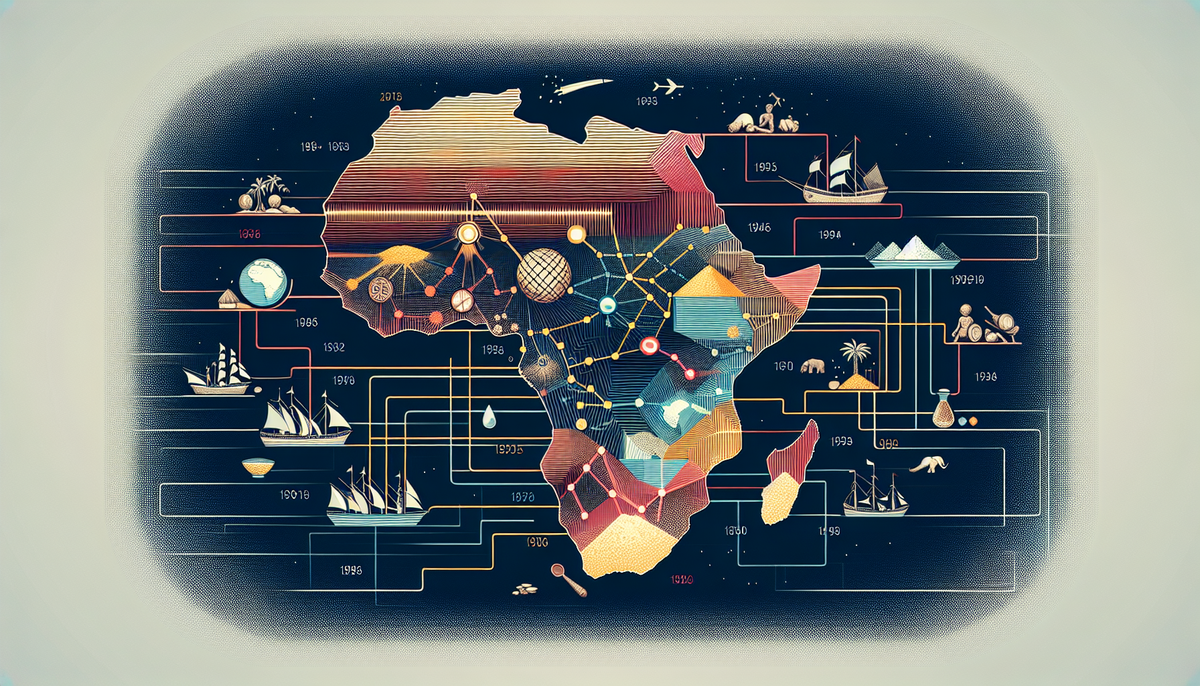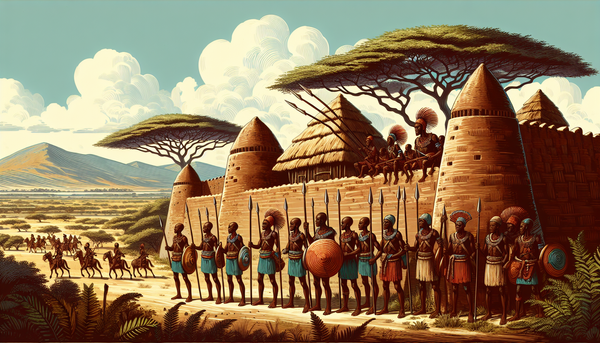The Evolution of African Trade Networks over Millennia

Origins and Early Trade Routes in Prehistoric Africa
The origins of trade in Africa can be traced back to prehistoric times, long before the emergence of complex societies. Early communities engaged in the exchange of goods, ideas, and resources, often driven by necessity and environmental factors. Evidence suggests that hunter-gatherer groups participated in localized trade, bartering surplus resources such as stone tools, animal hides, and food items.
As societies developed, so did the networks of trade, expanding beyond small communities to encompass larger regions. One notable early trade route emerged along the Nile River, facilitating the exchange of goods between ancient Egypt and neighboring cultures. This central artery enabled the transport of commodities like gold, ivory, and papyrus, which became vital to the Egyptian economy.
Meanwhile, in the Sahara Desert, nomadic herders began to establish trade relationships with sedentary agriculturalists, exchanging livestock for grain and other goods. The development of the camel as a means of transport revolutionized these trade routes, allowing for more extensive connections across the arid landscape. Ultimately, these early trade interactions laid the groundwork for more sophisticated networks that would evolve over millennia, shaping the continent’s economic landscape and cultural exchanges.
Growth of Trans-Saharan Commerce in Antiquity
The growth of Trans-Saharan commerce during antiquity marked a transformative period in African trade history. This network connected sub-Saharan Africa with Northern Africa and beyond, facilitating the exchange of goods, cultures, and ideas. The introduction of the camel in the first few centuries AD revolutionized trade across the Sahara, enabling merchants to transport larger quantities of goods over long distances with greater efficiency.
Salt, gold, and textiles became crucial commodities in this burgeoning trade network. Ancient Ghana, Mali, and Songhai empires emerged as key players, capitalizing on their abundant natural resources. Gold from the Bambuk region flowed towards the north, where it was exchanged for salt from the Sahara, a commodity vital for preserving food. This exchange not only enriched the economies of the involved regions but also contributed to the rise of powerful trading empires.
Additionally, the spread of Islam along these trade routes facilitated cultural exchanges and established a common language and religious framework, further enhancing trade relations. As traders navigated the desert’s harsh conditions, they formed a network of oases, fostering communities that would become integral to the commercial and cultural interactions of the time. The impact of this commerce laid the groundwork for future economic development across the continent.
Influence of Islamic Merchants in the Medieval Period
The medieval period witnessed a significant transformation in African trade networks, largely driven by the influence of Islamic merchants. Following the rise of Islam in the 7th century, Muslim traders ventured into sub-Saharan Africa, establishing vital links between North Africa and the interior regions. Their extensive knowledge of trade practices, coupled with religious motivations, fostered a dynamic commercial environment that reshaped the continent's economy.
Islamic merchants introduced not only goods but also sophisticated trading techniques and financial practices such as credit and partnerships, enhancing economic transactions. Major trading cities like Timbuktu and Gao thrived as centers of commerce and learning, with scholars and traders converging to exchange knowledge and products. Gold, ivory, slaves, and textiles became highly sought-after commodities, with the wealth generated from these exchanges greatly influencing the political power of emerging empires such as the Mali and Songhai.
The spread of Islam also facilitated cultural exchanges, as merchants propelled the dissemination of religious beliefs, education, and Arabic language throughout the region. This cultural fusion enriched local societies, creating a lasting legacy that would shape Africa’s social and economic structures for centuries to come. Ultimately, the involvement of Islamic merchants was pivotal in integrating Africa into the broader global trade network during the medieval period.
Impact of European Colonization on Trade Dynamics
The advent of European colonization in the 15th century marked a profound shift in African trade dynamics, reshaping existing networks and introducing new economic structures. Initially motivated by the search for new markets and resources, European powers established trading posts along the African coast, which facilitated the rise of the transatlantic slave trade. This brutal system not only dismantled local economies and societies but also redirected the flow of African resources to fuel European industrialization.
As European nations sought to exploit Africa's rich natural resources, traditional trade relationships were disrupted. Indigenous traders were often marginalized or displaced, while European merchants gained unprecedented control over lucrative commodities such as gold, ivory, and rubber. This exploitation led to economic dependency, where African economies became largely focused on exporting raw materials to Europe, stifling local production and innovation.
Colonial policies enforced artificial boundaries and stifled interregional trade, while infrastructure developments primarily served to extract resources rather than promote local economic growth. Furthermore, the introduction of European currencies and trade practices altered traditional systems of exchange, leading to the erosion of indigenous trade networks. Ultimately, European colonization not only transformed trade but also left a lasting legacy of economic challenges that many African nations continue to grapple with today.
Post-Colonial Economic Strategies and Trade Policies
In the aftermath of colonial rule, many African nations faced the daunting challenge of rebuilding their economies while navigating the complexities of a global market. Post-colonial economic strategies focused on promoting self-sufficiency and reducing dependency on former colonial powers. Governments implemented various policies aimed at diversifying their economies, often prioritizing agriculture, mining, and manufacturing sectors in an effort to foster local production.
One significant approach was the establishment of state-owned enterprises, which sought to control key industries and retain a larger share of profits within the country. This was coupled with initiatives to boost regional trade among African nations, as countries began to recognize the potential of intra-African commerce. Organizations such as the African Union (AU) and the Economic Community of West African States (ECOWAS) emerged, advocating for economic integration and collaborative trade policies.
However, these efforts were often hampered by persistent challenges, including political instability, corruption, and inadequate infrastructure. Over time, many nations turned to international organizations for support, leading to the implementation of structural adjustment programs. Though these policies aimed to stimulate growth and improve trade relations, they sometimes resulted in social and economic strains, highlighting the ongoing struggle for sustainable development in post-colonial Africa.
Contemporary Pan-African Trade Agreements and Blocs
In recent years, there has been a concerted effort among African nations to enhance economic integration through contemporary Pan-African trade agreements and regional blocs. Recognizing the importance of intra-African trade for economic growth and development, various initiatives have been established to foster collaboration and reduce trade barriers.
A landmark achievement is the African Continental Free Trade Area (AfCFTA), launched in 2021, which aims to create a single market for goods and services across 54 African countries. By eliminating tariffs on a significant portion of intra-African trade, AfCFTA seeks to promote economic diversification, boost industrialization, and enhance the competitiveness of African businesses on the global stage. The agreement is expected to uplift millions out of poverty and foster sustainable economic growth by increasing intra-continental trade from around 16% to 50% in the coming years.
Additionally, regional economic communities such as the East African Community (EAC), Southern African Development Community (SADC), and Economic Community of West African States (ECOWAS) are playing crucial roles in promoting trade cooperation and economic stability among member states. These blocs support collaborative infrastructure development, trade facilitation measures, and policy harmonization, reinforcing Africa's commitment to collective economic progress while addressing the continent's developmental challenges.
Future Trends and Technological Advancements in Trade
The future of trade in Africa is poised for transformative changes driven by technological advancements and evolving market dynamics. Digitalization is emerging as a cornerstone for enhancing trade efficiency; e-commerce platforms are enabling businesses, particularly small and medium-sized enterprises (SMEs), to access broader markets beyond their local boundaries. Innovations in mobile banking and financial technology (fintech) are also facilitating smoother transactions, improving access to capital, and reducing payment delays within and across borders.
Moreover, advancements in logistics and supply chain management are revolutionizing trade operations. The adoption of blockchain technology promises greater transparency and security in transactions, helping to minimize risks associated with fraud and inefficiencies in supply chains. Additionally, improvements in data analytics are allowing businesses to better understand market trends and consumer behavior, enabling them to make informed decisions.
Sustainability is increasingly influencing trade policies, pushing businesses toward greener practices and products. The focus on sustainable trade aligns with global demands for environmental conservation and social responsibility, which will shape future trade agreements.
As Africa increasingly embraces these technological and social shifts, the continent is likely to witness enhanced regional cooperation, increased competitiveness in global markets, and a more resilient economic environment that fosters innovation and inclusivity in trade.



